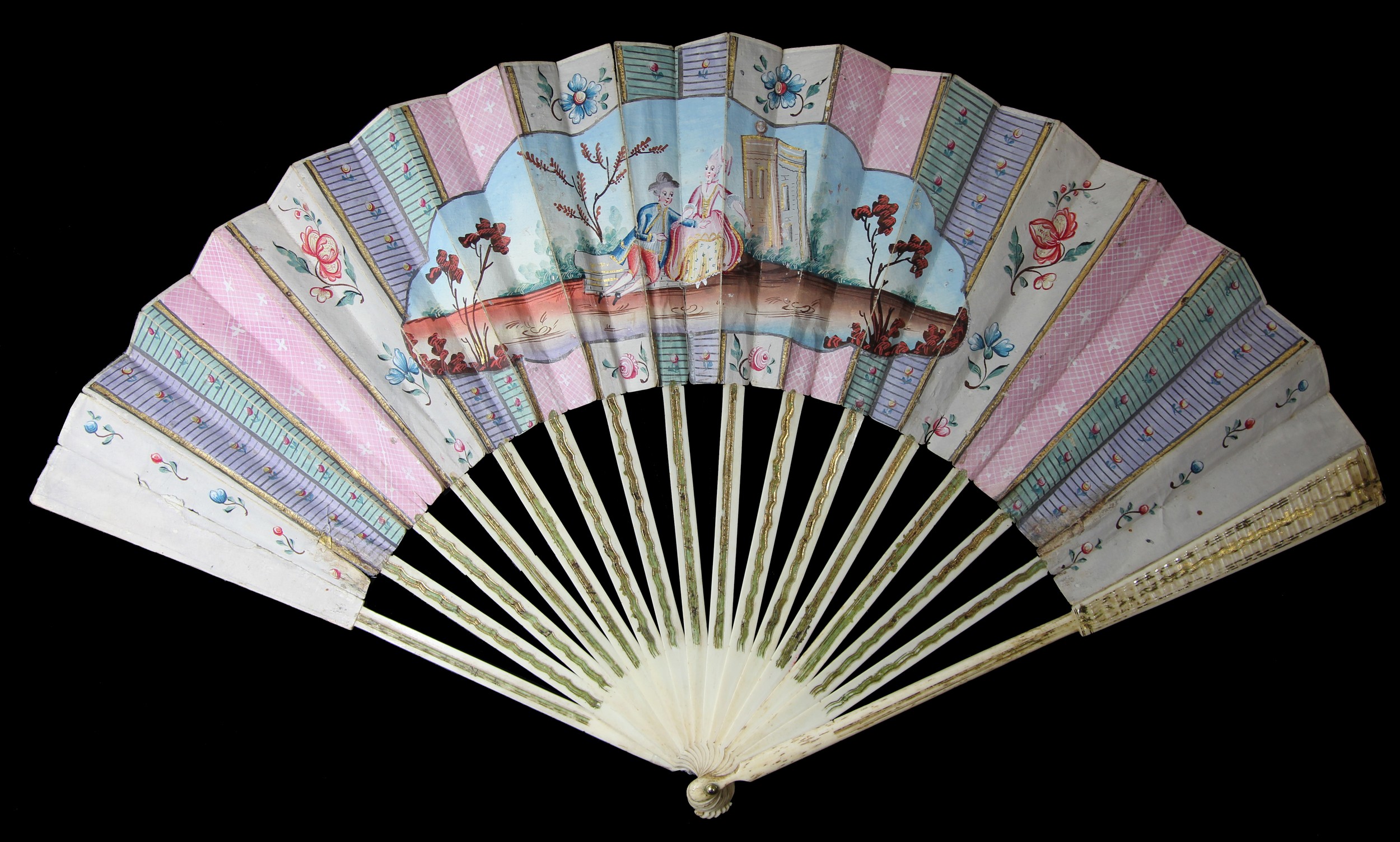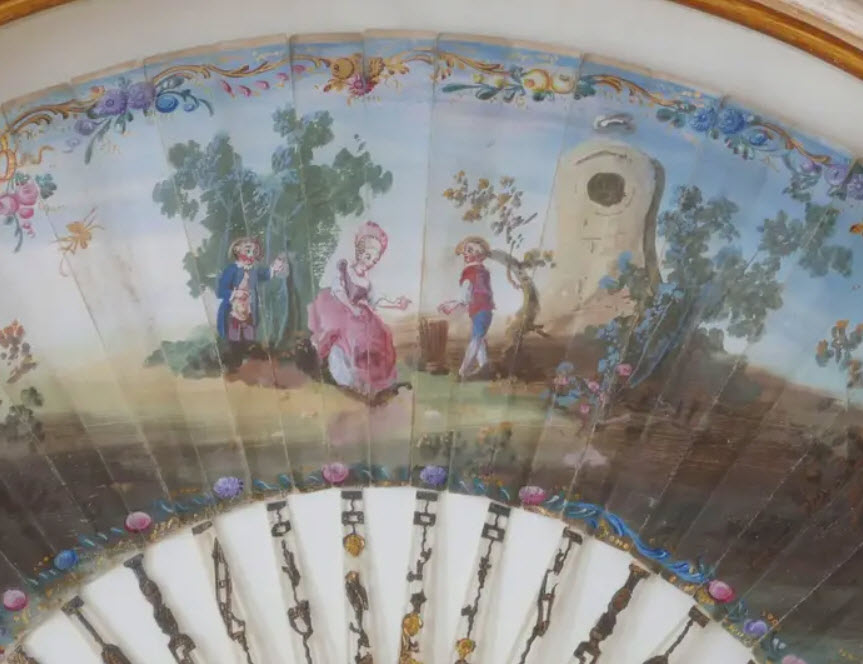Here
is a fan which seems without mystery, but which however raises a
question which we cannot answer, and which we are therefore going to
ask you.
But
first, let's describe it. It is a fan with 14 sticks (plus 2 guards).
The sticks appear to be made in ivory and the guards in bone, with a
metallic rivet (brass?). The sticks are slightly engraved and gilded
with straight or sinuous strips. The guards, decorated in the same way,
are wavy in their upper part. The double leaf is made of laid paper,
without a trade watermark that we can see by transparency. This leaf is
decorated on the recto with gouache, with gold highlights. The decor,
simple or even naive, shows a radiant distribution of 15 stripes (7
symmetrical on either side of a median one) each forming approximately
a fold and a counter-fold, all dotted with stylized flowers of various
sizes, on backgrounds of different colors, squared or striped. The
stripes are separated by golden borders. In the center, spanning 7
bands, a cartel with weavy borders shows a scene seen a thousand times,
representing in a conventional landscape with thin trees an elegant
couple. The young woman with high hair is half seated on a stone wall.
In front of her, a young hatted man seems to be flying (transported by
love?) Rather than standing on his knees in front of the beautiful girl.

So
here is a charming fan, probably inspired by furnishing or fashion
fabrics, which by its style seems to correspond to the first years of
the reign of Louis XVI, when the fashion of neoclassicism has not yet
completely triumphed. The dimensions as
the number of sticks also allow such dating in the late 1770s or early
1780s. The verso is as often very simple, consisting only of a branch
of old roses. The only originality: at
the upper left edge of the sheet, a handwritten note; alas we do not
know what it may mean.
We
will welcome all the thoughts that this modest fan can arouse. But it is a detail that makes us wonder. Indeed,
behind our couple of lovebirds is a high tower, which perhaps
symbolizes the castle where they will prove more intimately their love.
But what do we see at the top of this
tower?
What is this circular shape, or this
sphere, which seems to be placed on a tripod? In
our 21st century eyes, this looks like a satellite dish, or the
water tanks that we see on roofs in some countries prone to drought.
But in the 18th century? This is the simple, naive and frank question that we are
asking you.

This kind of decoration is occasionally found on fans from the end of the 18th century. With the authorization of their owner (whom we thank), we reproduce here a detail of a folded fan with an ivory monture and a double leaf in gouached and gilt silk, probably dating from the early 1780s. an edifice that appears to have openings and topped with such a disk. You will also notice the presence - so frequent, and so frequently unnoticed! - of a seller of oublies, these kinds of conical waffles also called "plaisirs (pleasures)", hence sometimes some bawdy innuendos. The sale was usually done using a lottery arrow attached to the top of the drum containing the treats.

Already answers!
Several of our correspondents have shared their suggestions.
Ms Мария Сергеева (who also showed us the image of a curious tightrope disc by Paul Outerbridge -1934-) wrote: "Very
interesting! And the house is like a modern one! A search for images
gave fragments of the crucifixion of the Balkans of the XIVth century.
It is not very similar, but perhaps to give a direction to the thought
". In support of her words, she shared the image opposite. It must be
recognized that there is a certain similarity, and that one could think
that on the fan, this small disc is nothing other than a sun or a moon".
Also very credible was the observation of Lorraine Taylor-Kent, President of the Fan Circle International: "As you have observed, the image is naively painted, and I see the 'tower' as a stone ornament with a small globe on top".
This observation seems common sense. However,
the naive and clumsy nature of this painting also allows us to see in
the construction -if not a pagoda such as the one erected in Kew by
William Chambers or for the Dud de Choiseul in Chanteloup-, at least an
edifice raised accordingly to the taste which during the second half of
the century: the Désert de Retz column, the "Folie-Beaujon" mill
embellishing the park of the future Palais de l'Elysée, or the "tour de
Malborough" built in Bellevue in 1784 by C.-L. Châtelet for Mesdames (the king's aunts).
That is why I answered: "However
I think that if the "tower" was a stone ornament, which is very
possible, the "globe" would be bigger and without legs. I think that on
thousands of 18th century fans I have seen it is the fist time I see
this. We also sometimes see clocks (perhaps related with a somewhat
bawdy "heure du berger") but clocks need needles and here the
charactersare not shepherds (even for "bergerades").
To this Lorraine Tailor-Kent answered, again with common sense: "I
agree with you and would have thought the Globe to have been much
larger but the person who drew the scene had little experience or even
direct memory of 'elegant gardens and stone structures'. I guess
this was a fairly cheap fan to produce and would have appealed to those
of modest means and who would have delighted in the possession of a
fan. I do feel that , although the dimensions of the
structure are weird, -it is not a tower but a much nearer artifact as
the greenery seems quite close to the couple and structure.
I did wonder if it was an arch as the colour of larger 'face' is
different......but an arch would surely have indicated a more important
structure leading to something to be noticed...........and this is a
very simple courting scene in a garden.....as a lady would not have
ventured into the countryside alone with a young man."
As for Anna Checcoli, Italian collector (see in particular her site http://www.ventagli.org/),
she has posted a detail of a fan with on a curious building a disc
quite similar to the one we are showing, but without feet. This would
corroborate the hypothesis of the president of the Fan Circle
International. However it could be a dovecote... and the surprising
building that leans next to it makes us think of a construction covered
with mirrors...
|
|
...and Serge Davoudian, the well-known antiques dealer and hand fans specialist, gave me another lead: "On the terrace [...] probably a standing mirror ... I let you judge to see the symbols there. Maybe a face"

Domaine public, https://commons.wikimedia.org/w/index.php?curid=503708 |
To
tell the truth, this possibility of a mirror was in my mind before I
asked this question here. But I hadn't studied it. My correspondent's
remark led me to some additional research, which leads me to a new
hypothesis, which seems to me to be fairly well founded.
I therefore suggest (until better suggestion) to see in the disc
appearing on our fan a "burning mirror", that is to say a mirror
intended to set fire. These mirrors are commonly called Archimedes'
mirrors, since the great ancient philosopher and physicist is presumed
to have, by this means, set fire to a fleet which besieged the city of
Syracuse.
It is uncertain that Archimedes has ever succeeded in such a feat,
especially with a floating objective by nature moving ... But many
believed it, and some have tried to reproduce the experiment. An
attempt was thus made before King Louis XIV, of which there remains an
interesting testimony in the Musée des Arts et Métiers in Paris,
evoked by a short video.
But it was the great naturalist Buffon, first a physicist, who
presented in 1747, for several weeks in the Jardin du Roi in Paris (now
Jardin des Plantes) a successful experiment, using a mirror in fact
composed more than a hundred adjustable mirrors, a kind of copy of it
remaining in the same museum, which we show below.

|
The
mirror shown above cannot be the one used by Buffon for the related
experiments, as it included more than a hundred small mirrors ... but
it allows us to grasp the principle, perfectly explained by the
scientist himself (document). The newspapers of the time reported on this experiment. (See here what the Mercure de France says in May 1747). The general public was perhaps only interested in it in 1774, when Buffon published the volume of his famous Histoire Naturelle
where this subject was discussed. The same year, M. de Bernières, who
had collaborated in 1747 with Buffon made a new experiment in the
Jardin de l'Infante in Paris (at one of the extremities of the Louvre).
The
taste that had then developed for science and physics experiments
certainly led some other curious people to try an experiment that many
of us undoubtedly carried out, when we were children, with a simple
mirror or with a magnifying glass.
It would not be surprising if a fan made, albeit clumsily, allusion to
these mirrors. We also know of fans showing other scientific
experiments. Let us cite, without being exhaustive, the "Claude
glasses" used for designing landscapes, the electrical experiments of
the Chanoine Nollet, the projections of Augustin or Robertson... and,
of course, the balloons of Montgolfier, Charles and Robert and others (See our page about balloons).The
taste that had then developed for science and physics experiments
certainly led some other curious people to try an experiment that many
of us undoubtedly carried out, when we were children, with a simple
mirror or with a magnifying glass.
But those who know us are aware that we are always trying to find out
what the fans say, not through the ridiculous coded language invented
in the 19th century, but through the real "fan language" which can be
read in the objects illustrations. Here, if the "burning mirror"
hypothesis is correct, what do we see? Against a background of flowers,
with meanings perhaps to look for (they are often linked to
feelings...) we see this couple of lovers and an instrument allowing to
set fire. This mirror, if it is a mirror, would it be there as a modern
equivalent of putti carrying flaming torches, or of Cupid bending his
bow?
AWat do you think? We really are not sure of the answer.
We will not fail to pass on your
suggestions, if possible with illustrations contemporary with our fan.
Thanks a lot for your
answers (use the address on the
home
page). And please have a look at our other
questions ! Browse on this Place de l'Eventail !
|